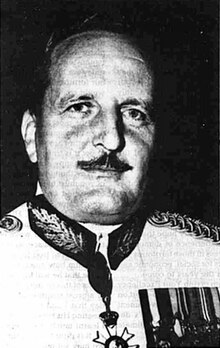Alexander Nicol Anton Waddell
Alexander Waddell | |
|---|---|
 | |
| 4th Governor of Sarawak | |
| In office 23 February 1960 – 15 September 1963 | |
| Monarch | Elizabeth II |
| Preceded by | Anthony Abell |
| Succeeded by | Office abolished |
| Personal details | |
| Born | Alexander Nicol Anton Waddell 8 November 1913 Eassie, Angus, Scotland |
| Died | 14 June 1999 (aged 85) Gloucestershire, England, United Kingdom |
| Spouse |
Jean Margot Lesbia Masters
(m. 1949) |
| Alma mater | University of Edinburgh (MA) |
| Profession | Diplomat |
| Signature | |
| Military service | |
| Branch/service | |
| Years of service | 1942–1944 |
| Rank | Lieutenant Colonel |
| Unit | Royal Australian Naval Volunteer Reserve |
| Battles/wars | World War II |
Sir Alexander Nicol Anton Waddell
Early life and education
Born on 8 November 1913 at Eassie, Angus, he is the youngest child of the Rev. Alexander Waddell, a more than 40-year Church of Scotland minister in Eassie.[2] Waddell received his education at Dundee's Harris Academy, a scholarship to Edinburgh's Fettes College,[5] and Edinburgh University, where he earned his M.A. He then attended Cambridge's Gonville and Caius College.[6][7]
Career

Motivated by a
In 1945, he went back to the British Solomon Islands to serve as the Central Solomons District Commissioner. The next year, he served in
Gambia
During his four years of service, Waddell was named
Governor of Sarawak
In a ceremony that took place in the Council Negri Chamber in Kuching on the afternoon of 23 February 1960, Waddell was sworn in as Sarawak's governor and commander-in-chief in 4:00 pm,[9] Sir Alexander and Lady Waddell disembarked with the Private Secretary, G.T. Barnes from the Bentong onto the Astana barge in tow. They arrived in Pangkalan Batu. After inspecting the Guard of honour stationed in front of the Brooke Memorial, Sir Alexander—dressed in formal dress—was given a presentation by the Chief Secretary, along with several others. The Chief Justice administered the Oath of office and the Chief Secretary read the Commission appointing him in the Council Chamber.[6]
Speaking in Malay during his installation, he made a name for himself fast by giving a thorough tour of the interior and demonstrating the warmth of the hospitality that he and his wife, Jean, provided at Astana, the former Rajah Brooke resident. Politically, it was a challenging period. The decision to include North Borneo and Brunei into Malaya instead of federate them infuriated Indonesia, sparking years of border fighting.[5]
Later life
From 1965 to 1977, Waddell served as the United Kingdom Commissioner for the
In the middle of the 1970s, the long-running and bitter issue ultimately made its way to the
Honours
During World War II in 1944, Waddell got the Distinguished Service Cross and was welcomed by the Queen Elizabeth (now Queen mother) at Buckingham Palace upon his return to the United Kingdom. In June 1959, it was declared that he had been awarded the C.M.G. and later promoted to Order of St Michael and St George (K.C.M.G.).[6] Known honours awarded to him are:[11]
 Knight Commander of the Order of St Michael and St George (KCMG) – Sir; Companion (CMG; June 1959)
Knight Commander of the Order of St Michael and St George (KCMG) – Sir; Companion (CMG; June 1959) Distinguished Service Cross (DSC; 1944)
Distinguished Service Cross (DSC; 1944)
References
- ^ a b "Sub Lieutenant Alexander Nicol Anton Waddell". www.awm.gov.au. Retrieved 1 November 2023.
- ^ a b c d "The British Empire". www.britishempire.co.uk. Retrieved 1 November 2023.
- ^ a b Leone, Sierra (1957). Ordinances of the Colony of Sierra Leone. Government Printer, South Africa.
- ISBN 978-1-136-50962-9.
- ^ a b c d e f "Obituary: Sir Alexander Waddell". The Independent. 23 June 1999. Retrieved 1 November 2023.
- ^ a b c d e f Ah Chon, Ho. Kuching 1960–1963 Sir Alexander Waddell's Era (PDF). Kuching: See Hua News Daily.
- ^ The International Year Book and Statesmen's Who's who. Kelly's Directories, Limited. 1979. p. 697.
- ^ "Papers of Sir Alexander Nicol. A. Waddell – Archives Hub". archiveshub.jisc.ac.uk. Retrieved 1 November 2023.
- ^ Sarawak (1963). The Sarawak Government Gazette. p. 87.
- ^ University of Edinburgh Journal. 1999. p. 136.
- ^ Office, Great Britain Colonial (1959). Sarawak: Report for the Year. H.M. Stationery Office. p. 233.
